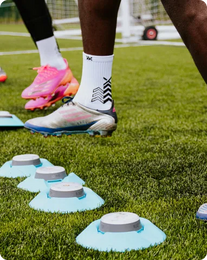Agility drills for soccer emphasize that the game is not unidirectional; it requires frequent changes of direction throughout the match. Players often sprint short distances, typically around 10-20 yards, demanding high explosiveness and quickness to reach the ball first. This makes speed and agility exercises for soccer crucial for effective training sessions. Wondering, ‘How can I increase my soccer speed and acceleration?’ Keep reading to discover the best ways to enhance your speed and agility.

What is Agility in Soccer?
Agility in soccer refers to the ability to move quickly and easily, with an emphasis on sudden changes in direction. Modern soccer demands players to be more agile than ever due to the quick direction changes and fast movements required. Effective agility exercises in soccer combines coordination, balance, strength, and power, enabling players to adjust their balance and shooting power swiftly to strike the ball accurately.

Soccer Agility Drills and Muscles
Soccer is a physically demanding sport that requires the use of nearly every muscle fiber in the body. Whether aiming to win a header, reach the box first, or save the ball, players need to engage various muscles quickly. Therefore, agility workouts for soccer should target the entire musculature, enhancing muscle strength and explosiveness, making players fast and agile.
How to Improve Your Agility in Soccer
Most soccer speed and agility drills don’t require much space, benefiting those without access to full-size pitches and training centers. This accessibility allows players to train effectively in limited spaces, focusing on exercises that enhance speed and agility, crucial for top performance on the field. So, if you want to know which soccer skill is an example of agility, give these drills a try.

Plyometric Hurdle Rebounds
Plyometric exercises, commonly known as jump training, are powerful aerobic activities utilized by athletes in various sports to enhance agility, strength, and speed. Among the different versions of plyometric workouts, hurdle exercises stand out as some of the best speed and agility training for soccer. They are particularly effective for building power, improving coordination, and enhancing jumping ability.
How to Set Up
- Arrange 5 agility hurdles 3-5 feet apart.
- This agility training soccer drill can be performed using hurdles of any size. Depending on your fitness level and experience, you may start with mini-hurdles and work your way up to waist-level hurdles.
How to Execute
- Stand with your feet hip-width apart.
- Jump upward and forward to clear the first hurdle, ensuring you land on both feet.
- Upon landing, immediately jump off your toes, using your arms to generate lift, and continue to clear all 5 hurdles.
- Repeat this sequence three to five times to complete one set.
- Rest for 1-2 minutes and then complete 2 more sets.
Acceleration and Deceleration Shuttles
Soccer involves frequent short bursts of speed, requiring excellent acceleration and deceleration skills. A player who accelerates quickly gives their opponents less time to react. Conversely, rapid deceleration allows for creating space from opponents, receiving passes, changing direction, and executing successful plays.
Increase the intensity by spacing the hurdles further apart. As you advance, try completing the jumps on one foot, alternating between your right and left foot.
How to Set Up
- You will need 6 training cones.
- Create a gate using 2 cones placed half a meter apart.
- From the first gate, measure 5 steps straight ahead and place a single cone.
- Take another 5 steps and place another single cone.
- Take 5 more steps and set up the second gate directly opposite the first gate.
How to Execute
- Stand at the first gate with one foot forward and knees slightly bent.
- Sprint towards the first cone, decelerate, and backpedal around it from left to right.
- After rounding the first cone, sprint to the second cone, go around it from left to right, and sprint through the final gate.
- Turn around and repeat the steps heading back towards the first gate, alternating the direction around the cones.
- Complete 3 repetitions (back and forth) to finish one set. Rest for 2 minutes.
These drills enhance speed and agility training for soccer, helping players improve their explosive power and responsiveness on the field.

Lateral Speed Training (Agility Ladder Drills Soccer)
Lateral speed training is a top exercise for enhancing speed in soccer, as you’ll discover in these agility ladder drills for soccer workouts. Soccer's unpredictable nature means the ball can deflect in any direction at any moment. Developing lateral quickness - rapid side-to-side movement - along with lateral strength boosts your ability to spring, stop, and stabilize in any direction while maintaining speed and balance. This exercise also strengthens knee and ankle stability, crucial for soccer performance.
To set up this drill, lay your portable speed and agility ladder on a flat surface.
How to Execute
- Begin by lining up parallel to the ladder.
- Slightly bend your knees to lower your center of gravity.
- Lift your inside foot and place it inside the first rung of the ladder.
- As your inside foot lands, lift your outside foot and place it into the same box.
- Repeat this pattern through all the rungs, ensuring you land on the balls of your feet and touch each rung with both feet.
- Move back and forth along the ladder, alternating directions from right to left and left to right.
- Repeat this sequence three times to complete one set.
Agility Course
The agility course integrates several soccer speed drills into one comprehensive workout session. This setup exemplifies soccer quickness drills that involve running, jumping, backpedaling, and shuffling around various obstacles. The complexity of this activity offers numerous benefits for soccer players of all levels. Besides enhancing quickness, it also improves footwork, body control, and balance.
For this soccer quickness drill, you'll need at least 7 cones, 4 hurdles, and 4 training sticks (or additional cones if sticks are unavailable).
How to Set Up
- Place one cone at the starting point.
- Position another cone 90 degrees to your right and 10 wide steps away as the finishing point.
- From the starting point, count 5 wide steps and place the first hurdle.
- Position the remaining hurdles, keeping a distance of 5 feet (1.5 meters) between them.
- From the fourth hurdle, count 5 wide steps and place the first stick.
- Turn 45 degrees to your left, count 5 wide steps, and place the second stick.
- Turn 45 degrees to your right, count 5 steps, and place the third stick.
- Repeat this to place the fourth stick 45 degrees and 5 steps from the third stick.
- From the fourth stick, turn 90 degrees and count 10 wide steps to place Cone 1 in the direction of the finishing cone.
- From Cone 1, turn 45 degrees to your right, count 5 steps, and place Cone 2.
- Turn 45 degrees again from Cone 2, count 5 steps, and place Cone 3.
- From Cone 3, count 3 steps straight ahead and place Cone 4.
- Finally, turn 45 degrees to your right from Cone 4, count 5 steps, and place Cones.
How to Execute
- Players line up at the starting cone.
- The first player sprints forward and jumps over the hurdles with both feet, maintaining quick succession and explosiveness.
- After the hurdles, the player runs towards the sticks and shuffles around them, keeping knees bent and moving quickly.
- From Cone 1, the player sprints towards Cone 3 at max speed and then backpedals to Cone 2.
- The player then shuttles straight to Cone 5, backpedals to Cone 4, and finally sprints to the finishing cone.
- Walk back to the starting line.
- The next player can start as soon as the first player finishes jumping over the hurdles.
Tuck Jumps
Tuck jumps are a powerful addition to any team's quickness training drills. These plyometric exercises involve exerting maximum force to jump vertically, targeting core and lower body muscles. Tuck jumps help develop bilateral power output, enabling athletes to move explosively on both feet while maintaining power and coordination. Mastering tuck jumps not only boosts vertical leap height but also enhances speed and agility, allowing athletes to change direction quickly.
How to Execute
- Stand with your feet shoulder-width apart.
- Bend your hips and knees into a quarter-squat position.
- Jump straight up with maximum explosive force.
- As you jump, tuck your knees under your chest, bringing your thighs parallel to the floor.
- Straighten your legs by extending your knees. Land on the balls of your feet to absorb the impact.
- Perform 10 jumps to complete one set. Complete 3 sets with a 30-second rest between each set.
Incorporating tuck jumps into your training regimen will enhance overall athletic performance, boosting both vertical leap and quickness.

Ladder Work
Agility ladder drills are ideal for soccer footwork drills without a ball. It’s simple yet effective for players of all ages to enhance coordination, agility, footwork, and balance. In this drill, players move across the rungs of the agility ladder, completing various patterns designed to sharpen motor skills.
How to Set Up
- You'll need one portable agility ladder for every 10 players. You may want more than 1 ladder, depending on the number of players.
- Players should line up behind the ladder.
How to Execute
- The first player moves across the ladder, completing the pattern instructed by the coach or trainer. Examples include two-feet linear hops, hop-scotch, and the icky shuffle. Challenges can be as simple as moving through the ladder with one foot or two feet in each box.
- After completing the rungs, the player returns to the line.
- The coach/trainer should vary the challenges and have players repeat each pattern 2-4 times until they master the moves.
- The coach decides the duration of the activity based on the difficulty level, typically recommended for 8-12 minutes per session.
You should not look past this activity if you're looking for soccer footwork drills without a ball. While it's generally simple, it can be used by players and athletes of all ages to improve their coordination, agility, footwork, and balance.
In this soccer agility drill, the players move across the rungs of the agility ladder completing different patterns that are focused on sharpening their motor abilities.
Conclusion
BlazePod revolutionizes agility training for soccer players with its innovative coaster-sized pods and smartphone app. These light-based pods act as virtual coach cues, allowing players to train effectively even without a trainer. Thanks to their programmability, the pods can guide you through a customized training course, and they double as a competitive fitness device to track your speed and reaction times.























